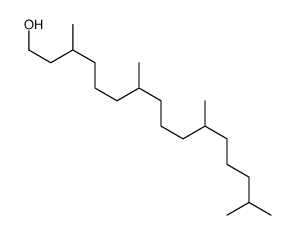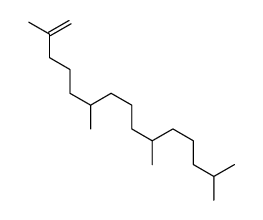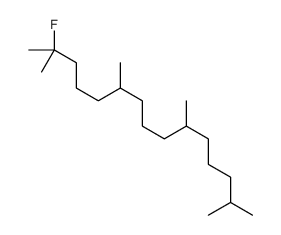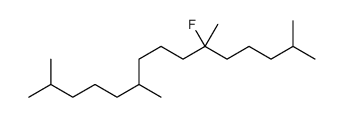Pristane

Pristane structure
|
Common Name | Pristane | ||
|---|---|---|---|---|
| CAS Number | 1921-70-6 | Molecular Weight | 268.521 | |
| Density | 0.8±0.1 g/cm3 | Boiling Point | 296.0±0.0 °C at 760 mmHg | |
| Molecular Formula | C19H40 | Melting Point | -99ºC | |
| MSDS | Chinese USA | Flash Point | 140.7±12.3 °C | |
| Symbol |

GHS07 |
Signal Word | Warning | |
Use of PristanePristane (Norphytane) is a naturally occurring hydrocarbon oil found in small quantities in many plants, in various marine organisms, and as the most active component of mineral oil[1]. Pristane is a non-antigenic adjuvant, and induces MHC class II-restricted, arthritogenic T cells in the rat[2]. |
| Name | pristane |
|---|---|
| Synonym | More Synonyms |
| Description | Pristane (Norphytane) is a naturally occurring hydrocarbon oil found in small quantities in many plants, in various marine organisms, and as the most active component of mineral oil[1]. Pristane is a non-antigenic adjuvant, and induces MHC class II-restricted, arthritogenic T cells in the rat[2]. |
|---|---|
| Related Catalog | |
| In Vitro | Pristane activates CD4+ αβT cells that are MHC class II restricted and arthritogenic[1]. |
| In Vivo | Pristane activates CD4+ alpha beta T cells that are MHC class II restricted and arthritogenic in vivo[2]. Animal Model: Naive recipient rats (DA)[2] Dosage: 500 μL of Pristane oil Administration: Intradermal injection Result: Both CD4+, CD8+ αβT cells and B cells significantly expand in draining lymph nodes until day 6 after injection, whereafter the CD4+ αβT cells continue to expand until day 12 after injection. |
| References |
| Density | 0.8±0.1 g/cm3 |
|---|---|
| Boiling Point | 296.0±0.0 °C at 760 mmHg |
| Melting Point | -99ºC |
| Molecular Formula | C19H40 |
| Molecular Weight | 268.521 |
| Flash Point | 140.7±12.3 °C |
| Exact Mass | 268.312988 |
| LogP | 10.11 |
| Appearance of Characters | liquid | Clear colorless |
| Vapour Pressure | 0.0±0.3 mmHg at 25°C |
| Index of Refraction | 1.436 |
| Stability | Stable. Combustible. Incompatible with strong oxidizing agents. |
CHEMICAL IDENTIFICATION
HEALTH HAZARD DATAACUTE TOXICITY DATA
|
| Symbol |

GHS07 |
|---|---|
| Signal Word | Warning |
| Hazard Statements | H315-H319 |
| Precautionary Statements | P305 + P351 + P338 |
| Personal Protective Equipment | Faceshields;full-face respirator (US);Gloves;Goggles;multi-purpose combination respirator cartridge (US);type ABEK (EN14387) respirator filter |
| Hazard Codes | Xi |
| Risk Phrases | R36/38 |
| Safety Phrases | S24/25 |
| RIDADR | NONH for all modes of transport |
| WGK Germany | 3 |
| RTECS | RZ1880000 |
| HS Code | 2901100000 |
|
~% 
Pristane CAS#:1921-70-6 |
| Literature: Organic Letters, , vol. 9, # 2 p. 299 - 302 |
|
~% 
Pristane CAS#:1921-70-6 |
| Literature: Organic Letters, , vol. 9, # 2 p. 299 - 302 |
|
~% 
Pristane CAS#:1921-70-6 |
| Literature: Organic Letters, , vol. 9, # 2 p. 299 - 302 |
|
~% 
Pristane CAS#:1921-70-6 |
| Literature: Chemistry Letters, , # 3 p. 206 - 207 |
|
~% 
Pristane CAS#:1921-70-6 |
| Literature: Acta Chemica Scandinavica (1947-1973), , vol. 3, p. 942 |
|
~% 
Pristane CAS#:1921-70-6 |
| Literature: Tanaka, Katsunori; Fukase, Koichi Organic Process Research and Development, 2009 , vol. 13, # 5 p. 983 - 990 |
|
~% 
Pristane CAS#:1921-70-6 |
| Literature: Acta Chemica Scandinavica (1947-1973), , vol. 3, p. 942 |
|
~9% 
Pristane CAS#:1921-70-6
Detail
|
| Literature: Chemistry Letters, , # 3 p. 206 - 207 |
|
~% 
Pristane CAS#:1921-70-6 |
| Literature: Journal of the Chemical Society, , p. 5706 - 5713 |
| HS Code | 2901100000 |
|---|---|
| Summary | 2901100000 saturated acyclic hydrocarbons。Supervision conditions:None。VAT:17.0%。Tax rebate rate:9.0%。MFN tariff:2.0%。General tariff:30.0% |
|
No evidence of pathogenic involvement of cathelicidins in patient cohorts and mouse models of lupus and arthritis.
PLoS ONE 9(12) , e115474, (2014) Apart from their role in the immune defence against pathogens evidence of a role of antimicrobial peptides (AMPs) in autoimmune diseases has accumulated in the past years. The aim of this project was ... |
|
|
IL-17 promotes murine lupus.
J. Immunol. 193(2) , 540-3, (2014) The proinflammatory activity of IL-17-producing Th17 cells has been associated with the pathogenesis of several autoimmune diseases. In this article, we provide direct evidence for a role of IL-17 in ... |
|
|
Positional identification of RT1-B (HLA-DQ) as susceptibility locus for autoimmune arthritis.
J. Immunol. 194(6) , 2539-50, (2015) Rheumatoid arthritis (RA) is associated with amino acid variants in multiple MHC molecules. The association to MHC class II (MHC-II) has been studied in several animal models of RA. In most cases thes... |
| Norphytan |
| 2,6,10,10-Tetramethylpentadecane |
| 2,4-DIPHENYL-6-(4'-METHOXYPHENYL)PYRYLIUM PERCHLORATE |
| 2,6,10,14-Tetramethylpentadecane |
| Pristane |
| Pristan |
| Pentadecane, 2,6,10,14-tetramethyl- |
| MFCD00008952 |
| EINECS 217-650-8 |
| Norphytane |
| Bute hydrocarbon |
| UNII-26HZV48DT1 |
| Pentadecane,2,6,10,14-tetramethyl |
| 2,6,10,14-tetramethyl pentadecane |










 CAS#:90304-31-7
CAS#:90304-31-7 CAS#:90304-32-8
CAS#:90304-32-8
